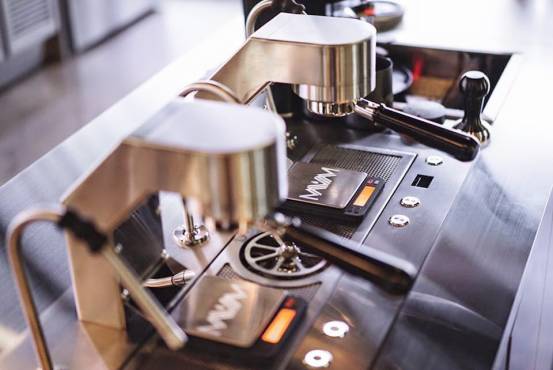The difference between a mug and a coffee cup
Follow the caf é (Wechat official account vdailycom) and found that Beautiful Cafe opened a small shop of its own.
The color, size and temperature of the coffee cup all have an impact on the coffee reference experience.
I. material aspect
Mugs are made of a wide range of materials, including ceramics and plastics. Glass and stainless steel and so on. Among them, the mugs made of bone porcelain are of the best quality and the highest quality. The ceramic cup is made of nothing more than pottery and porcelain, which is more limited.
Second, styling
Compared with ceramic cups, mugs have diversified shapes and richer colors. The body of mugs can be designed into different types of shapes, such as anime characters, lovely animals, plants and so on. Family commonly used mugs can generally hold liquid ranging from 150 ml to 350 ml.
III. Characteristics
The mug made of bone porcelain contains more than 40% high-value natural animal bone powder, lead-free, cadmium-free and radiation-free, and is known as "as thin as paper, as loud as sound, as white as jade and as bright as a mirror". Moreover, the texture of the bone porcelain mug is light, fine and hard, not easy to wear and break, moderate light transmittance and heat preservation, and the color is a natural milky white unique to natural bone powder. It is a green consumer product for environmental protection.
IV. Performance
Mugs are also relatively better at keeping warm. For ease of use, most mugs are designed to be used directly in microwave ovens, but there are a few special cases that need to be used according to the manufacturer's instructions.
[color]
Researchers from the Commonwealth University of Australia and the University of Oxford in the UK began to prove the truth after a barista said that white cups would make coffee taste more bitter. They found 36 volunteers to take part in the experiment and tested the claim with coffee cups in blue, white and transparent colors. In one of the experiments, volunteers thought white coffee cups "enhanced" the taste of coffee more than transparent coffee cups, according to an academic report published in the journal Flavour.

In the second experiment, the volunteers thought the coffee in the blue and transparent coffee cups tasted sweeter than the white coffee cups, and of the two coffee cups, the volunteers thought the coffee in the blue coffee cups was the sweetest.
Scientists believe that people may associate brown with bitterness, and because the coffee in a white coffee cup looks closest to brown, people will also think it tastes the bitterest. The lead author of the report, Dr George Doorn from the Commonwealth University of Australia, wrote in an article at the request of The Conversation: "our research clearly shows that the color of coffee cups does have an effect on people's sense of taste and smell when drinking coffee. Our academic report on the impact of coffee cup color on coffee taste suggests that coffee shop owners, baristas and porcelain manufacturers should all seriously consider the color of their coffee cups, because this potential effect can affect the number of repeat customers in their business. "

[size]
Small coffee cups below 100CC
It is mostly used to hold strong and boiling hot espresso or individual coffee, such as espresso with only 50CC, Viennese coffee (concentrated + cream top) and macchiato (concentrated + foam top). Although you can drink it almost in one mouthful, you can taste it a little bit with a small coffee cup to prolong the pleasure of the coffee as much as possible. The Cappuccino with milk foam has a slightly larger capacity than Espresso. The wide mouth of the cup can show the rich and beautiful foam.
Ordinary coffee cups around 200CC
The most common coffee cups, light American coffee, mostly choose such cups, which have enough space to mix on their own to facilitate the addition of milk and sugar.
Mugs above 300CC or milk coffee cups for French Ole
Coffee with a lot of milk, such as lattes, American mochas and multi-purpose mugs, is enough to contain its sweet and diverse taste. The French are used to using a large bowl of milky coffee (Ole Coffee) to render a mood of joy that lasts all morning.
There are still traces to judge the difference between the teacup and the coffee cup from the shape and size. Usually, in order to retain the rich aroma of coffee and reduce temperature evaporation, the mouth of the coffee cup is narrower and the cup body is wider. On the other hand, most of the black tea cups have a wide mouth and high light transmittance to reflect the clear and transparent brown color.
[temperature]
A necessary step in making coffee is to warm the cup. In general, the top of the household semi-automatic espresso machine has a platform for holding coffee cups, which can heat the cup body. Once freshly extracted coffee is poured into a cold cup, the flavor will be greatly reduced. Therefore, the heat conduction and heat preservation of coffee cups are also critical to coffee tasting experience. In the process of making bone porcelain cup, an appropriate amount of animal bones is added to the raw material, which can slow down the decrease of coffee temperature, with a proportion of about 25% bone powder and 75% high-grade porcelain clay. Features: light texture (weight), strong light transmittance, soft color, high density (fragile, easy to clean) high temperature resistance (good thermal insulation)
Important Notice :
前街咖啡 FrontStreet Coffee has moved to new addredd:
FrontStreet Coffee Address: 315,Donghua East Road,GuangZhou
Tel:020 38364473
- Prev

Evaluation of the use of MAVAM ESPRESSO coffee machine
It has not been a day or two since Mavam brushed the screen. Last month, the founder Michael came to China. I had the honor to have some communication with him. I have a deeper understanding of the design concept and performance of this machine. I would like to share it with you here. About MAVAM- in April 2015, Mavam Espresso was born in a warehouse at U.S. Capitol Hill on 11th Avenue in Seattle.
- Next

What should be paid attention to in the etiquette in the coffee cup test?
About Cupping senior colleagues, to explore the coffee, looking for a suitable for their own beans, will definitely be exposed to the cup test system. For finding beans, sharing coffee, and exercising the taste senses, cup testing is a simple and rare tool. But what the normal cup testing process needs to pay attention to is what many operators do not pay attention to. The author particularly hates unlimited participation.
Related
- What is the Philharmonic pressure? How to use Philharmonic pressure to make delicious coffee
- Why does a hand grinder have more fine powder than an electric grinder?
- In addition to the hot mom, what is the difference between the versions of EK43 | ditting and Mahdi ek43?
- What kind of equipment do you need to make coffee by hand? Introduction to novice starter cooking equipment tools
- Espresso needs to be ground how thick and thin scale entry Italian Coffee Machine Bean Grinder investigation and Grinding course
- How much does it cost to open a small private cafe? How much does it cost to learn coffee? How to operate it?
- The difference between the flavor characteristics of hand-brewed coffee and coffee maker is hand-brewed coffee really better than coffee maker? Can I use a coffee machine to make coffee beans by hand?
- The difference between 01 and 02 of hario v60 filter cup what is the difference between 01 and 02 filter cup opening and cooking flavor
- What's the difference between the smart cup and the French kettle? Which is better, the French kettle or the Smart Cup?
- What's the difference between a smart cup and a V60 filter cup? The difference between the taste of smart cup and hand-brewed coffee

